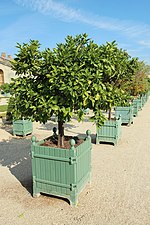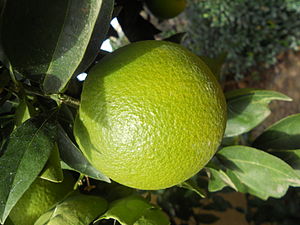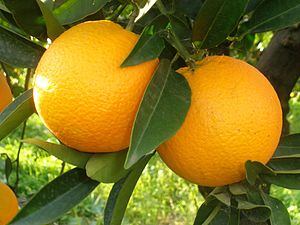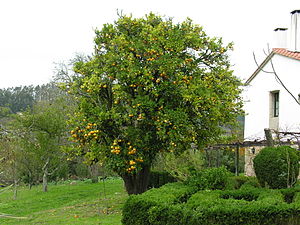Citrus × sinensis
This article needs additional citations for verification. (April 2017) |
| Citrus × sinensis | |
|---|---|
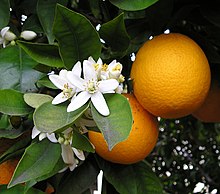
| |
| Scientific classification | |
| Kingdom: | Plantae |
| Clade: | Tracheophytes |
| Clade: | Angiosperms |
| Clade: | Eudicots |
| Clade: | Rosids |
| Order: | Sapindales |
| Family: | Rutaceae |
| Genus: | Citrus |
| Species: | C. × sinensis
|
| Binomial name | |
| Citrus × sinensis (
Osbeck[1] | |

| |
| Synonyms | |
|
Citrus × sinensis (L.) Osbeck | |
Citrus × sinensis (sometimes written Citrus sinensis), a hybrid between
navel oranges.[1]
Uses
The orange fruit is an important agricultural product, used for both the juicy fruit pulp and the aromatic peel (rind). Orange blossoms (the flowers) are used in several different ways, as are the leaves and wood of the tree.
Flowers
- The state flower of Florida,[2]is highly fragrant and traditionally associated with good fortune. It has long been popular in bridal bouquets and head wreaths.
- Orange blossom essence is an important component in the making of perfume.
- Orange blossom petals can also be made into a delicately citrus-scented counterpart to sconesand marshmallows.
- In Spain, fallen blossoms are dried and used to make orange tea.
- beehives in the citrus groves while trees bloom. By this method, bees also pollinate seeded citrus varieties. This type of honey has an orangey taste and is highly prized.[citation needed]
Leaves
- Orange leaves can be boiled to make orange tea.
Wood
- Orangewood sticks are used as cuticle pushers in manicures and pedicures, and as spudgers for manipulating slender electronic wires.
- Orangewood is used in the same way as mesquite, oak, and hickory for seasoning grilled meat.
-
Orange trees in movable pots, so that they can be placed indoors for the winter
-
Orange flowers
-
Unripened fruit
-
Blood oranges
-
Oranges on the branch
-
Oranges on a tree
-
A mature tree inGalicia, Spain
Chemical composition
Orange fruit and leaf both are reported to contain indole alkaloids including
N,N-DMT.[citation needed
]
Threats
Giant swallowtail larva
Giant swallowtail caterpillars (Papilio cresphontes) cause serious damage to this crop, especially to young trees.[3]
See also
- The orange blossom gives its touristic nickname to the Castellónseaboard.
- Citrus greening disease - bacterial disease killing orange trees and other citrus fruits grown
References
Wikispecies has information related to Citrus sinensis.
https://powo.science.kew.org/taxon/urn:lsid:ipni.org:names:772052-1
- ^ a b "Citrus sinensis". Germplasm Resources Information Network. Agricultural Research Service, United States Department of Agriculture. Retrieved 2015-09-29.
- ^ "Florida State Symbols". Florida Department of State. Division of Historical Resources. Archived from the original on 2014-04-27. Retrieved 2015-09-29.
- ^ "Giant Swallowtail, Orangedog, Papilio cresphontes Cramer (Insecta: Lepidoptera: Papilionidae)1 (PDF Download Available)". ResearchGate. Retrieved 2017-11-14.
External links
- Porcher Michel H.; et al. (1995–2002), Sorting Citrus Names. Multilingual Multiscript Plant Name Database (M.M.P.N.D) - A Work in Progress, The University of Melbourne, Australia
- Xu, Q.; Chen, L.-L.; Ruan, X.; Chen, D.; Zhu, A.; Chen, C.; Bertrand, D.; Jiao, W.-B.; Hao, B.-H.; Lyon, M.P.; Chen, J.; Gao, S.; Xing, F.; Lan, H.; Chang, J.-W.; Ge, X.; Lei, Y.; Hu, Q.; Miao, Y.; Wang, L.; Xiao, S.; Biswas, M.K.; Zeng, W.; Guo, F.; Cao, H.; Yang, X.; Xu, X.-W.; Cheng, Y.-J.; Xu, J.; Liu, J.-H.; Luo, O.J.; Tang, Z.; Guo, W.-W.; Kuang, H.; Zhang, H.-Y.; Roose, M.L.; Nagarajan, N.; Deng, X.-X.; Ruan, Y. (2013), "The draft genome of sweet orange (Citrus sinensis)", Nature Genetics, 45 (1): 59–66, PMID 23179022
- Bausher, Michael G; Singh, Nameirakpam D; Lee, Seung-Bum; Jansen, Robert K; Daniell, Henry (2006). "The complete chloroplast genome sequence of Citrus sinensis (L.) Osbeck var 'Ridge Pineapple': Organization and phylogenetic relationships to other angiosperms". BMC Plant Biology. 6: 21. PMID 17010212.

